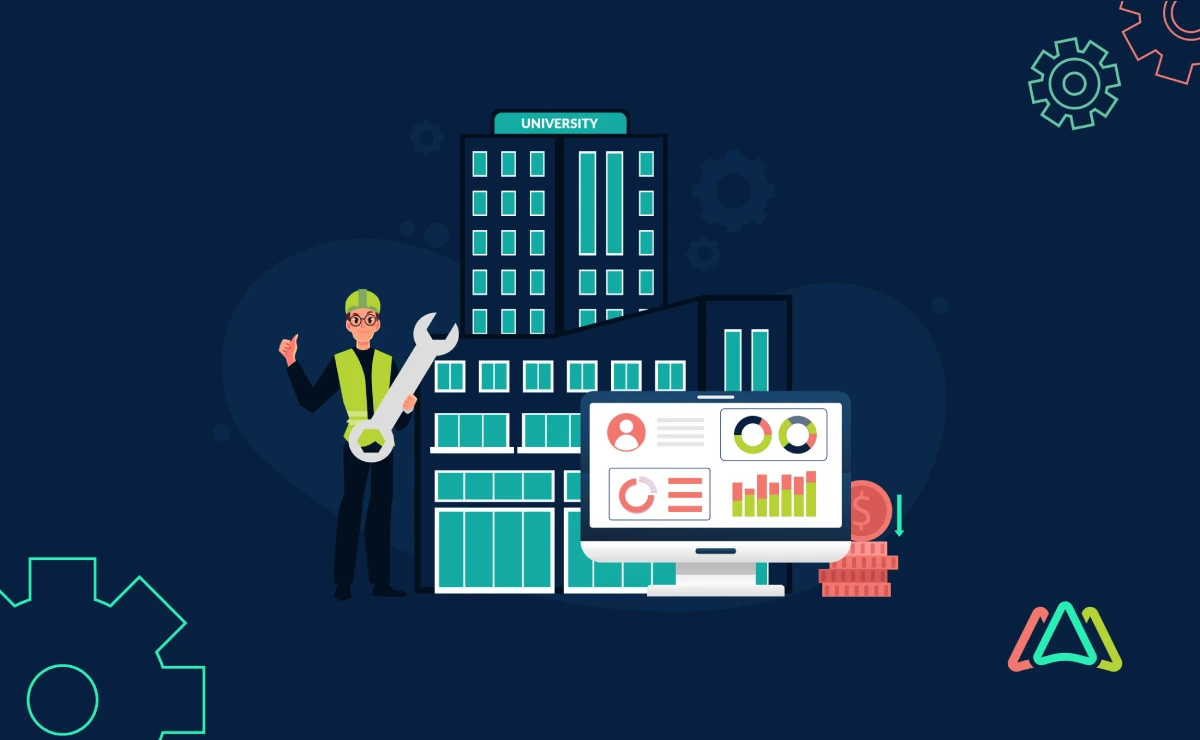
Using CMMS Software to Cut Costs in the Higher Education Industry
The United States' research-performing universities and colleges have reported a significant increase in science and engineering research space over the past decade. With a total of 236.1 million net assignable square feet (NASF) in 2021, this marks a 17% increase since 2011. However, it's crucial to note that this only accounts for S&E research space and doesn't include other spaces like classrooms, administrative offices, and residential buildings. This means that the total facility space of all colleges and universities in the U.S. is even more extensive than 236.1 million NASF. As of 2023, approximately 18.66 million college students were enrolled in higher education institutions in the United States. It's worth mentioning that 22.7% of these students opted for fully online programs, indicating a growing trend toward remote learning. However, the remaining students were engaged in either on-campus education or a hybrid model that includes both in-person and online courses. These numbers show that the higher education facilities are growing in size to accommodate the increasing number of students they serve. As such, it's essential to support and invest in these institutions to ensure that they continue to provide quality education and research opportunities that benefit individuals and society as a whole.
Higher education facilities provide services to large amounts of people and require efficient and effective maintenance operations to be successful. Similar to other facilities management operations, universities, and colleges are increasingly challenged to remain budget-conscious while optimizing operations and maintaining high standards. However, unlike facilities in different industry sectors, such as manufacturing, healthcare, or hospitality, higher education facilities' maintenance operations differ in several ways, which add to the challenges just noted.
Universities and colleges present unique maintenance challenges due to the diverse and constantly evolving nature of their facilities and operations. These institutions typically encompass various building types, including academic buildings, laboratories, dormitories, food services, sports complexes, and administrative offices, each with specialized maintenance requirements. In addition, the high volume of foot traffic, varying usage patterns, and stringent regulatory requirements further complicate maintenance efforts. Moreover, universities often operate on tight budgets and face pressure to minimize disruptions to academic activities, making it essential to prioritize preventive maintenance and efficient resource allocation.
The dynamic nature of campus environments and the need to balance cost-effectiveness with delivering high-quality services underscores the complexity of maintenance management in the higher education sector. For these reasons, the higher education industry recognizes the need to embrace modern maintenance management solutions. This is where Computerized Maintenance Management Software presents as an effective solution. CMMS software is a powerful tool that has caught the attention of organizations across a wide range of industries, transforming maintenance management and facility operations and offering substantial cost-saving opportunities.
In this article, we delve into the various ways CMMS software can significantly reduce costs in the higher education sector.

Understanding CMMS Software
CMMS software is a centralized hub for managing an organization's maintenance activities, work orders, assets, and resources. It streamlines processes, enhances communication, and empowers decision-making by providing real-time insights into maintenance operations. CMMS software enables users to schedule preventive maintenance tasks, create and assign work orders, track and manage spare parts, manage vendor contracts, and generate reports. CMMS empowers organizations to enhance productivity, minimize downtime, extend asset lifespan, and optimize resource allocation by providing real-time insights into maintenance operations and asset performance. Ultimately, CMMS software facilitates proactive maintenance management, enabling organizations to reduce costs, improve operational efficiency, and maintain high-quality standards, reliability, and regulatory compliance.
Preventive Maintenance: A Proactive Approach
One of the core features of CMMS software is preventive maintenance scheduling. In a university's maintenance operations, preventive maintenance is key to ensuring the smooth functioning of facilities and infrastructure. By proactively scheduling maintenance tasks based on equipment condition, usage patterns, and manufacturer recommendations, CMMS software helps prevent potential breakdowns, unsafe environments, and costly emergency repairs.

Preventive maintenance minimizes downtime and disruptions to academic activities and extends the lifespan of assets, optimizing the university's return on investment. Moreover, CMMS preventive maintenance enables facility managers to identify and address issues before they escalate, ensuring a safe and reliable campus environment for students, faculty, and staff. By streamlining maintenance workflows, prioritizing tasks, and facilitating data-driven decision-making, CMMS preventive maintenance enhances operational efficiency, reduces costs, and supports the university's mission of providing high-quality education and services.
Work Order Management Made Seamless
Efficient work order management is essential for ensuring timely response to maintenance requests and optimizing resource allocation. CMMS software facilitates the creation, assignment, tracking, and completion of work orders efficiently. CMMS Work Order Management offers numerous benefits to higher education facilities by streamlining maintenance processes and optimizing resource utilization. Whether repairing a leaky faucet or servicing HVAC systems, streamlined work order management ensures that tasks are addressed promptly, reducing disruptions to academic activities and enhancing overall operational efficiency.
With CMMS software, universities can efficiently create, assign, track, and prioritize maintenance tasks, ensuring timely resolution of issues across campus. This system facilitates clear communication between maintenance teams, administrators, and stakeholders, improving coordination and transparency. By automating work order generation and assignment, CMMS software eliminates manual paperwork and reduces administrative overhead, allowing staff to focus on more strategic tasks. Additionally, tracking work order status in real-time enables administrators to monitor progress, identify bottlenecks, and allocate resources effectively. Overall, CMMS work order management enhances cost-savings and operational efficiency, reduces response times, and improves the overall campus experience for students, faculty, and staff.
Optimizing Facility Management Processes
Facility management encompasses many tasks, including space utilization, safety compliance, and energy management. Some advanced CMMS platforms include modules for tracking space occupancy, scheduling routine inspections, and managing vendor contracts, CMMS empowers facility managers to streamline processes, identify inefficiencies, and allocate resources judiciously, ultimately resulting in cost savings.
CMMS optimizes facility management processes by providing a robust platform for overseeing all operations within higher education institutions. Through CMMS software, facility managers can efficiently manage space utilization, track maintenance schedules, monitor energy consumption, and ensure compliance with safety regulations. By automating routine tasks, such as inspections and preventive maintenance, CMMS reduces administrative burden and minimizes downtime, ultimately leading to cost savings and improved operational efficiency across the campus.
Real-Time Data for Informed Decision-Making
In the fast-paced environment of higher education, timely access to accurate data is crucial for making informed decisions. CMMS software offers real-time insights into maintenance activities, asset performance, maintenance history, and resource utilization. Administrators and facility managers can leverage this data to identify trends regarding budget allocation, resource planning, and equipment replacement, optimizing operational workflows and maximizing ROI. Moreover, CMMS facilitates transparency and accountability by providing visibility into maintenance activities and history, fostering a culture of continuous improvement and efficiency within the university environment. Substantive cost reductions and improved productivity can be achieved by prioritizing maintenance tasks, allocating budgets effectively, making informed decisions on asset replacement, and optimizing operational workflows.
Streamlining Compliance and Audit Processes
Maintaining preventive maintenance compliance with regulatory standards and industry guidelines is paramount for educational institutions. CMMS software simplifies compliance management by centralizing documentation, automating audit trails, and facilitating regulatory reporting. By ensuring adherence to safety protocols, environmental regulations, and industry standards, CMMS software helps universities mitigate risks, avoid penalties, and uphold their reputation.

CMMS software reduces the administrative burden associated with compliance management and minimizes the risk of non-compliance penalties and fines. Moreover, CMMS enables universities to monitor equipment performance, track maintenance activities proactively, and address potential safety hazards, ensuring a safe and secure campus environment for students, faculty, and staff.
Cost-Effective Resource Allocation
Effective resource allocation is essential for maximizing efficiency and minimizing waste. CMMS software enables universities to track inventory levels, manage spare parts, and optimize procurement processes. CMMS software helps institutions save significant costs while ensuring maintenance operations run smoothly.

Exploring this issue more deeply, higher education facilities benefit significantly from CMMS software because it provides comprehensive insights into asset usage, maintenance history, and inventory consumption, and stock levels, allowing universities to make informed resource allocation and budgeting decisions. By eliminating unnecessary stockpiling, reducing inventory carrying costs, and negotiating favorable vendor contracts, CMMS software helps institutions achieve significant cost savings while ensuring that maintenance operations run smoothly. Additionally, CMMS facilitates proactive maintenance scheduling and equipment lifecycle management, allowing universities to extend the lifespan of assets and minimize costly emergency repairs.
Overall, CMMS's cost-effective resource allocation capabilities empower higher education facilities to maximize efficiency, minimize waste, and allocate resources more effectively, ultimately enhancing their financial sustainability and operational resilience.
Enhancing Stakeholder Satisfaction
In the competitive landscape of higher education, maintaining high levels of stakeholder satisfaction is paramount. Whether it's students, faculty, or administrative staff, everyone benefits from a well-maintained and safe campus environment. By minimizing disruptions, ensuring facility reliability, and enhancing the overall campus experience, CMMS software contributes to higher stakeholder satisfaction levels, fostering a positive academic environment conducive to learning and innovation.
Moreover, CMMS enhances higher education stakeholder satisfaction by ensuring timely response to maintenance requests, efficient work order management, and proactive preventive maintenance scheduling, contributing to a sense of reliability and trust among stakeholders. Finally, CMMS's ability to provide real-time data insights enables administrators to address issues promptly, allocate resources effectively, and prioritize projects based on stakeholder needs. By creating a transparency, accountability, and continuous improvement culture, CMMS software enhances stakeholder satisfaction, fosters positive relationships, and strengthens the institution's reputation within the higher education community.
The Bottom Line: Investing in CMMS Software
Implementing CMMS software presents a compelling opportunity for universities and colleges to cut costs, optimize operations, and enhance overall competitiveness in higher education. By leveraging preventive maintenance strategies, streamlining work order management processes, optimizing facility operations, and harnessing real-time data insights, CMMS software empowers institutions to achieve significant cost savings while maintaining high standards of quality and reliability.
As higher education institutions navigate the complexities of the modern landscape, investing in CMMS software emerges as a strategic imperative for driving operational excellence, fostering innovation, and delivering tangible value to stakeholders. By embracing technology-driven solutions and prioritizing efficiency and sustainability, universities can position themselves for long-term success in an increasingly competitive environment.
TABLE OF CONTENTS
Keep Reading
Ever find yourself checking into a luxury hotel and expecting a relaxing stay, only to find a ...
11 Apr 2025
Organizations are witnessing swift changes in the business environment and confronting a ...
8 Apr 2025
Last month, news outlets and the entire internet was abuzz with the return of NASA astronauts ...
3 Apr 2025
What comes first - CMMS or predictive maintenance? If your answer is either, it is correct. ...
28 Mar 2025
Artificial intelligence (AI) talk has become commonplace. Today, engaging in business-focused ...
27 Mar 2025
Imagine a world where machines predict, diagnose, and fix their issues before they fail. This ...
25 Mar 2025
A facility maintenance plan is at the core of a facility’s operations. This organized ...
21 Mar 2025
Think of managing your maintenance operations like managing a championship sports team. Just ...
21 Mar 2025
The maintenance sector is battling a severe talent shortage that threatens to undermine ...
7 Mar 2025
Manufacturing maintenance is the backbone of industrial efficiency, ensuring machines run ...
5 Mar 2025
No one likes playing a guessing game when equipment breaks down. Yet, maintenance teams often ...
4 Mar 2025
The size of the preventive maintenance software market is discussed in millions of dollars, ...
4 Mar 2025
The organizational structure and corporate hierarchy vary from company to company. Large ...
28 Feb 2025
Maintenance procedures are essential for ensuring the longevity and reliability of machinery ...
21 Feb 2025
Sustainability is no longer just a buzzword; it's a critical component of corporate social ...
20 Feb 2025
A Computerized Maintenance Management System (CMMS) relies on accurate, well-organized data ...
18 Feb 2025
In an era where technology drives operational efficiency, Computerized Maintenance Management ...
14 Feb 2025
A Computerized Maintenance Management System (CMMS) is a key component of modern maintenance ...
13 Feb 2025
Introduction Maintenance management is the foundation of maintenance operations in industries ...
11 Feb 2025
Introduction A Computerized Maintenance Management System (CMMS) is software designed to help ...
7 Feb 2025





